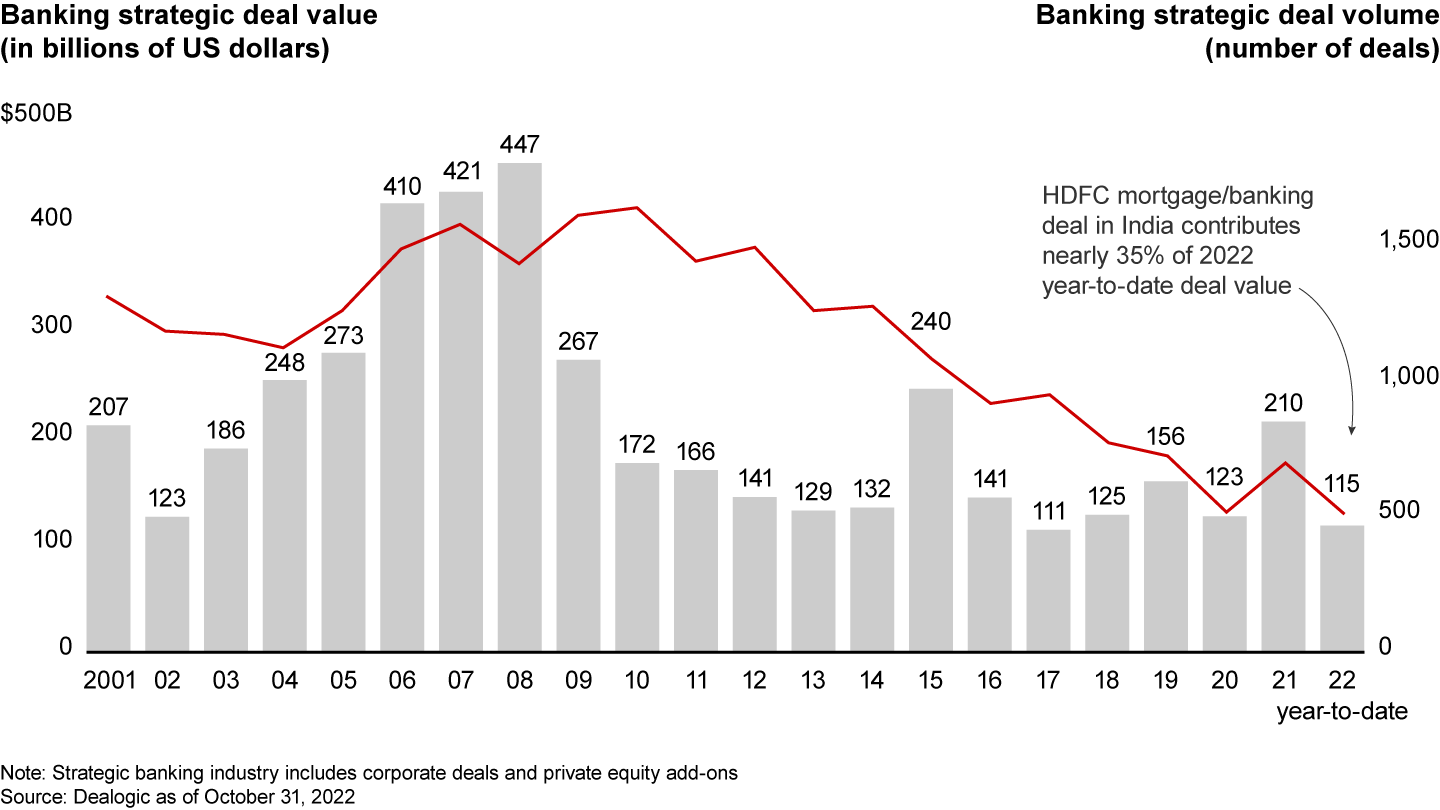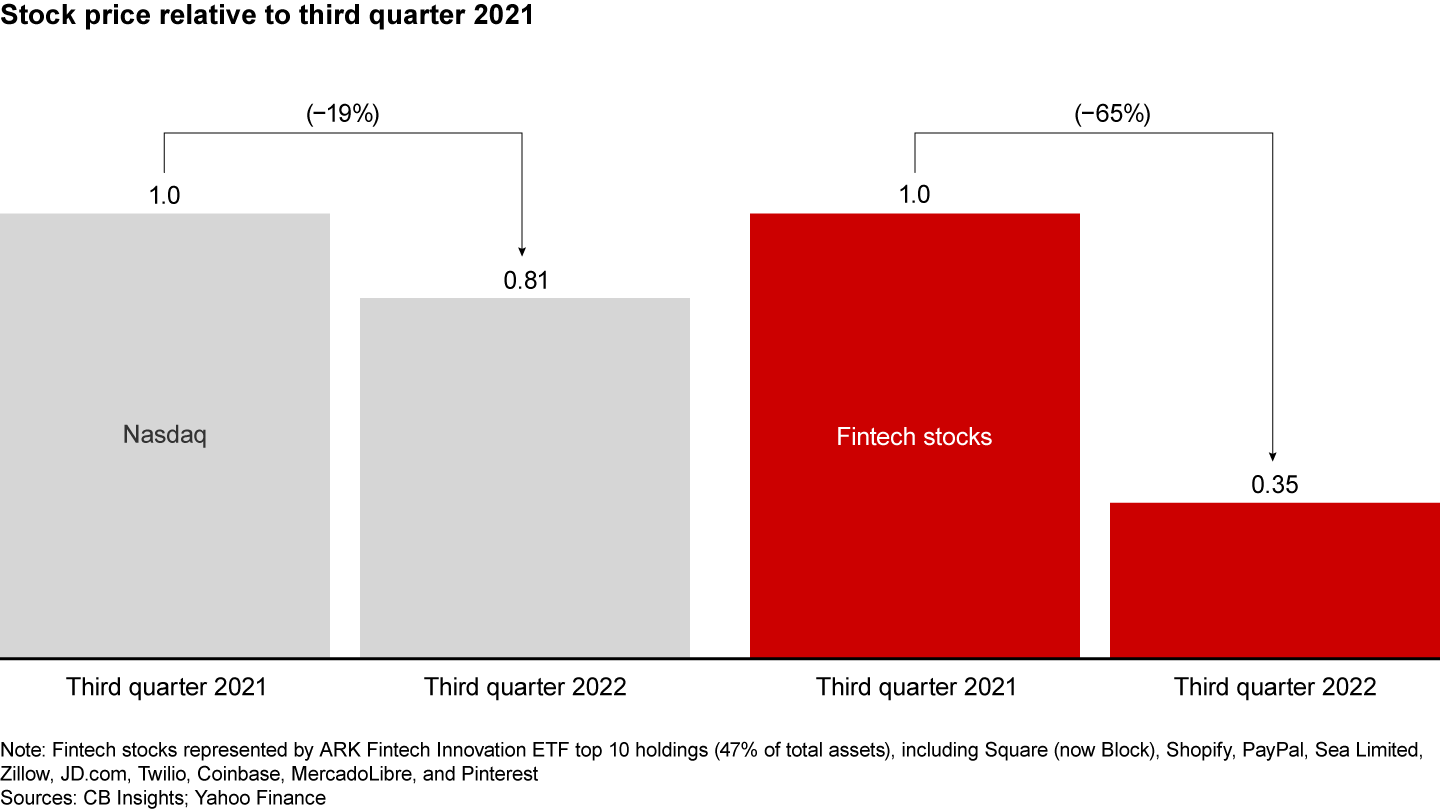M&A Report

At a Glance
- More than half of total banking M&A in 2022 involved deals valued at greater than $5 billion vs. around 25% throughout the previous 10 years.
- To improve operations in the downturn, many banks will sell off or find partners for units that are noncore or subscale, requiring significant investment.
- More banks are acquiring to establish a new growth engine, expand current product and service offerings, and gain distinctive capabilities and competencies.
This article is part of Bain's 2023 M&A Report.
Similar to so many other industries, banking saw M&A activity stall in mid-2022 amid rising interest rates and mounting macroeconomic concerns (see Figure 1). But we expect the year 2023 to be one in which more banks turn to M&A to deliver on strategies that will better position them as the industry continues to rapidly evolve.


Several trends will make M&A an attractive option. Higher interest rates will bolster top-line growth for healthy banks while a downturn could make it necessary for less sturdy banks to merge or sell. In Europe and other regions where banking is fragmented, regulators are showing support for scale deals. As digital options emerge and customer needs change, banks are determining where they want to play and how they want to compete. They are looking to sell noncore assets and buy new capabilities to deliver their portfolio strategy faster, cheaper, and more effectively than they could on their own. Expect more deals similar to National Australia Bank’s 2021 acquisition of neobank 86 400 to spur the growth of its UBank digital-only bank.
We expect to see three types of strategic deals in 2023: scale deals for consolidation, scope deals to focus on the core, and deals for a new growth engine. More than half (51%) of total banking M&A in 2022 involved deals valued at greater than $5 billion compared with around 25% throughout the previous 10 years.
As digital options emerge and customer needs change, banks are determining where they want to play and how they want to compete.
Scale deals for consolidation
We’ve already seen BMO Financial announce a $16.3 billion purchase of Bank of the West from BNP Paribas, enabling the Canada-based bank to almost double its presence in the US. The deal also allows BNP to make a strategic move by exiting the US to cash in and invest significant resources in potential deals in other geographies. Another 2022 scale deal involved Toronto Dominion Bank’s announced $13.4 billion acquisition of First Horizon, which also is aimed at enabling a Canadian bank to expand its US footprint.
Banks pursuing scale M&A in the current uncertain macroeconomic environment require a clear understanding of how healthy their business is and how well their operating infrastructure can integrate new assets. They also require a deeper focus on due diligence than they are accustomed to taking (see the chapter “Tougher Times: Putting the Diligence Back in Due Diligence”). For example, acquirers need to stress test the potential deal’s ability to create value in different scenarios. That means ensuring the quality of the target’s capital will hold up. It’s also critical to understand whether the target’s digital infrastructure (i.e., how it manages data) is suitable and easily integrated. Buyers need to make sure the best talent will be protected and integrated the right way. And even in geographies where regulators are encouraging consolidation, it’s important to invest the time up front to anticipate and satisfy any possible regulatory concerns.
Scope deals to help a bank focus on its core
Downturns are a time for companies to improve operations and sharpen the focus on where they should invest resources. The answer for many will be to sell off or find partners for units that are noncore or subscale, with no clear competitive advantage, and that require significant investment. Consider that in Australia, all banks have either divested their wealth management assets or are in the process of doing so. Specialized players and private equity funds are increasingly willing to invest in such deals, taking advantage of less competition and more favorable valuations in a downturn.
Sellers need to make sure what they’re selling is consistently performing and that there are clear asset boundaries in the agreement. Also important: finding a buyer with a strong parenting advantage and that could become a source of future business.
Many banks will sell off or find partners for units that are noncore or subscale.
Deals for a new growth engine
We call them Engine 2 businesses. They are new businesses within existing companies that use the scale benefits of the core business and of their client base to grow faster than a new start-up could. Some banks are pursuing innovative fintech assets that enable them to expand their current product and service offerings as well as provide them with distinctive capabilities and competencies. Either way, it’s an opportunity to diversify and improve revenue streams. Valuations for fintechs have dropped significantly in 2022 (see Figure 2).


More banks will follow the path of JPMorgan Chase, which in 2021 bought Nutmeg, an independent digital wealth management adviser, to complement the launch of its Chase brand in the UK online banking market. It followed up that acquisition in 2022 with the purchase of cloud-native payments tech firm Renovite. The move helps JPMorgan Chase modernize its tech infrastructure and create greater flexibility for its merchant acquiring capabilities globally. In another 2022 deal, Société Générale agreed to buy a majority stake in payment fintech PayXpert. Acquiring that asset strengthens the bank’s payment solutions in Europe for retail and online merchants.
These deals require special considerations. Number one is ensuring the quality and distinctiveness of digital components and how they will be integrated into a buyer’s strategy. Also, since there’s a high risk of losing talent in scope capability deals, the best companies create a specialized approach to retaining talent. For example, to the extent possible, they develop a program to engage mission-critical talent as if they were entrepreneurs—that is, with independence and tailored compensation.
More banks will turn to M&A to help them navigate a rapidly changing industry in a downturn. The banks that emerge as leaders will be those that rigorously prepare for the challenges that are unique to the types of deals they pursue.